Projections of the Net Primary Production of Terrestrial Ecosystem and Spatiotemporal Responses to Climate Change in the Yangtze River Economic Belt
Abstract
:1. Introduction
2. Materials and Methods
2.1. Study Area
2.2. Model Description and Validation
2.3. Input Datasets
2.4. Simulations and Analysis
3. Results
3.1. Estimated Vegetation NPP in the Current Climate
3.2. Projected Vegetation NPP Due to Future Climate Change
3.3. Spatial Responses of NPP to Future Climate Change
3.4. Vegetation NPP Responses to Global Warming
4. Discussion
4.1. The Effects of Warming
4.2. The Effects of Precipitation Changes
4.3. Factors Other Than Climate
5. Conclusions
Author Contributions
Funding
Institutional Review Board Statement
Data Availability Statement
Acknowledgments
Conflicts of Interest
References
- Settele, J.; Scholes, R.; Betts, R.; Bunn, S.; Leadley, P.; Nepstad, D.; Overpeck, J.T.; Taboada, M.A. Terrestrial and inland water systems. In Climate Change 2014: Impacts, Adaptation, and Vulnerability. Part A: Global and Sectorial Aspects. Contribution of Working Group II to the Fifth Assessment Report of the Intergovernmental Panel on Climate Change; Cambridge University Press: Cambridge, UK; New York, NY, USA, 2014; pp. 271–359. [Google Scholar]
- Vitousek, M.P.; Aber, D.J.; Howarth, W.R.; Likens, E.G.; Matson, A.P.; Schindler, W.D.; Schlesinger, H.W.; Tilman, G.D. Human aletation of the global nitrogen cycle: Sources and consequences. Ecol. Appl. 1997, 7, 737–750. [Google Scholar]
- Ito, A. A historical meta-analysis of global terrestrial net primary productivity: Are estimates converging? Glob. Chang. Biol. 2011, 17, 3161–3175. [Google Scholar] [CrossRef]
- Bonan, B.G.; Doney, C.S. Climate, ecosystems, and planetary futures: The challenge to predict life in Earth system models. Science 2018, 359, 6375. [Google Scholar] [CrossRef] [PubMed] [Green Version]
- Cramer, W.; Bondeau, A.; Woodward, I.F.; Prentice, I.C.; Betts, R.A.; Brovkin, V.; Cox, P.M.; Fisher, V.; Foley, J.A.; Friend, A.D. Global response of terrestrial ecosystem structure and function to CO2 and climate change: Results from six dynamic global vegetation models. Glob. Chang. Biol. 2001, 7, 357–373. [Google Scholar] [CrossRef] [Green Version]
- Bachelet, D.; Neilson, R.P.; Hickler, T.; Drapek, R.J.; Lenihan, J.M.; Sykes, M.T.; Smith, B.; Sitch, S.; Thonicke, K. Simulating past and future dynamics of natural ecosystems in the United States. Glob. Biogeochem. Cycles 2003, 17, 1045. [Google Scholar] [CrossRef] [Green Version]
- Wang, Z.; Chang, J.; Peng, S.; Piao, S.; Ciais, P.; Betts, R. Changes in productivity and carbon storage of grasslands in China under future global warming scenarios of 1.5 °C and 2 °C. J. Plant. Ecol. 2019, 12, 804–814. [Google Scholar] [CrossRef]
- Gerber, S.; Joos, F.; Prentice, I.C. Sensitivity of a dynamic global vegetation model to climate and atmospheric CO2. Glob. Chang. Biol. 2004, 10, 1223–1239. [Google Scholar] [CrossRef]
- Gang, C.C.; Zhang, Y.Z.; Wang, Z.Q.; Chen, Y.Z.; Yang, Y.; Li, J.L.; Cheng, J.M.; Qi, J.G.; Odeh, I. Modeling the dynamics of distribution, extent, and NPP of global terrestrial ecosystems in response to future climate change. Global. Planet. Chang. 2017, 148, 153–165. [Google Scholar] [CrossRef]
- Alo, C.A.; Wang, G. Potential future changes of the terrestrial ecosystem based on climate projections by eight general circulation models. J. Geophys. Res. 2008, 113, G01004. [Google Scholar] [CrossRef]
- Sun, G.D.; Mu, M. Assessing the characteristic of net primary production due to future climate change and CO2 under RCP4.5 in China. Ecol. Complex. 2018, 34, 58–68. [Google Scholar] [CrossRef]
- Piao, S.L.; Fang, J.Y.; Zhou, L.M.; Zhu, B.; Tan, K.; Tao, S. Changes in vegetation net primary productivity from 1982 to 1999 in China. Global. Biogeochem. Cycles 2005, 19, 1–16. [Google Scholar] [CrossRef] [Green Version]
- Wang, J.Y.; Delang, O.C.; Hou, G.L.; Gao, L.; Lu, X.X. Net Primary production increase in the Yangtze River Basin within the latest two decades. Glob. Ecol. Coserv. 2021, 26, e01497. [Google Scholar] [CrossRef]
- Zhao, D.; Wu, S.H.; Yin, Y.H. Responses of terrestrial ecosystems’ net primary productivity to future regional climate change in China. PLoS ONE 2013, 8, e60849. [Google Scholar] [CrossRef] [PubMed] [Green Version]
- Ren, W.; Tian, H.Q.; Tao, B.; Chappelka, A.; Sun, G.; Lu, C.Q.; Liu, M.; Chen, G.; Xu, X.F. Impacts of tropospheric ozone and climate change on net primary productivity and net carbon exchange of China’s forest ecosystems. Global Ecol. Biogeogr. 2011, 20, 391–406. [Google Scholar] [CrossRef]
- Liang, W.; Yang, Y.; Fan, D.; Guan, H.; Zhang, T.; Long, D.; Zhou, Y.; Bai, D. Analysis of spatial and temporal patterns of net primary production and their climate controls in China from 1982 to 2010. Agric. Forest Meteorol. 2015, 204, 22–36. [Google Scholar] [CrossRef]
- Li, J.; Wang, Z.; Lai, C.; Wu, X.; Zeng, Z.; Chen, X.; Liao, Y. Response of net primary production to land use and land cover change in mainland China since the late 1980s. Sci. Total. Environ. 2018, 639, 237–247. [Google Scholar] [CrossRef] [PubMed]
- Yu, L.; Gu, F.X.; Huang, M.; Tao, B.; Hao, M.; Wang, Z.S. Impacts of 1.5 °C and 2 °C Global Warming on Net Primary Productivity and Carbon Balance in China’s Terrestrial Ecosystems. Sustainability 2020, 12, 2849. [Google Scholar] [CrossRef] [Green Version]
- Yan, Z.W.; Ding, Y.H.; Zhai, P.M.; Song, L.C.; Cao, L.J.; Li, Z. Re-assessing climatic warming in China since the last century. Acta Meteorol. Sin. 2020, 78, 370–378. [Google Scholar]
- Dai, A. Increasing drought under global warming in observations and models. Nat. Clim. Chang. 2012, 3, 52–58. [Google Scholar] [CrossRef]
- Chen, N.; Gao, X. Climate change in the twenty-first century over China: Projections by an RCM and the driving GCM. Atmos. Ocean. Sci. Lett. 2019, 4, 270–277. [Google Scholar] [CrossRef] [Green Version]
- He, H.L.; Wang, S.Q.; Zhang, L.; Wang, J.B.; Ren, X.L.; Zhou, L.; Piao, S.L.; Yan, H.; Ju, W.M.; Gu, F.X.; et al. Altered trends in carbon uptake in China’s terrestrial ecosystems under the enhanced summer monsoon and warming hiatus. Natl. Sci. Rev. 2019, 6, 505–514. [Google Scholar] [CrossRef] [Green Version]
- Yu, G.R.; Chen, Z.; Piao, S.L.; Peng, C.H.; Ciais, P.; Wang, Q.F.; Li, X.R.; Zhu, X.J. High carbon dioxide uptake by subtropical forest ecosystems in the East Asian monsoon region. Proc. Natl. Acad. Sci. USA 2014, 111, 4910–4915. [Google Scholar] [CrossRef] [Green Version]
- Li, G.J. Adhere to the ecological priority, green development and advance the Yangtze River Economic Belt of the ecological environment protection work. Environ. Prot. 2016, 44, 7–13. (In Chinese) [Google Scholar]
- Luo, Q.L.; Luo, Y.L.; Zhou, Q.F.; Song, Y. Does China’s Yangtze River Economic Belt policy impact on local ecosystem services? Sci. Total. Environ. 2019, 676, 231–241. [Google Scholar] [CrossRef] [PubMed]
- Xu, X.B.; Yang, G.S.; Tan, Y.; Liu, J.P.; Hu, H.Z. Ecosystem services trade-offs and determinants in China’s Yangtze River Economic Belt from 2000 to 2015. Sci. Total. Environ. 2018, 634, 1601–1614. [Google Scholar] [CrossRef] [PubMed]
- Ke, J.H.; Piao, S.L.; Fang, J.Y. NPP and its spatiotemporal patterns in the Yangtze River watershed. Acta Phytoecol. Sin. 2003, 27, 764–770. [Google Scholar]
- Zhang, F.Y.; Zhang, Z.X.; Tian, J.X. Forest NPP simulation in the Yangtze River Basin and its response to climate change. J. Nanjing For. Univ. (Nat. Sci. Ed.) 2021, 45, 175–181. (In Chinese) [Google Scholar]
- Wu, N.; Gao, J.X.; Sudebilige, L.U.O.; Li, D.Q. Inter-annual variation trends of vegetation net primary productivity and its responses to climate factors in the upper Yangtze River basin. Resour. Environ. Yangtze Basin 2010, 19, 296–389. (In Chinese) [Google Scholar]
- Miao, Q.; Huang, M.; Li, R.Q. Impacts of climate change on vegetation net primary productivity of the Yangtze River Basin. J. Nat. Resour. 2010, 25, 1296–1305. (In Chinese) [Google Scholar]
- Wu, S.; Liu, L.; Gao, J.; Wang, W. Integrate Risk From Climate Change in China Under Global Warming of 1.5 °C and 2.0 °C. Earths Future 2019, 7, 1301–1322. [Google Scholar] [CrossRef] [Green Version]
- Ministry of Ecology and Environment of the People’s Republic of China; National Development and Reform Commission; Ministry of Water Resources. Environmental Protection Plan for the Yangtze River Economic Belt; Beijing; 2017. Available online: https://www.mee.gov.cn/gkm/hbb/bwj/201707/t20170118_418053.htm (accessed on 19 January 2017).
- Huang, M.T.; Piao, S.L.; Sun, Y.; Ciais, P.; Cheng, L.; Mao, J.F.; Poulter, B. Change in terrestrial ecosystem water-use efficiency over the last three decades. Glob. Chang. Biol. 2015, 21, 2366–2378. [Google Scholar] [CrossRef] [PubMed]
- Cao, M.K.; Woodward, I.F. Dynamic responses of terrestrial ecosystem carbon cycling to global climate change. Nature 1998, 393, 249–252. [Google Scholar] [CrossRef]
- Tao, B.; Cao, M.K.; Li, K.R.; Gu, F.F.; Ji, J.J.; Huang, M.; Zhang, L.M. Spatial patterns of terrestrial net ecosystem producticity in China during 1981–2000. Sci. China Earth Sci. 2007, 50, 745–753. [Google Scholar] [CrossRef]
- Gu, F.X.; Zhang, Y.D.; Huang, M.; Tao, B.; Liu, Z.J.; Hao, M.; Guo, R. Climate-driven uncertainties in modeling terrestrial ecosystem net primary productivity in China. Agric. Forest Meteorol. 2017, 246, 123–132. [Google Scholar] [CrossRef]
- Gu, F.; Zhang, Y.; Huang, M.; Yu, L.; Yan, H.M.; Guo, R.; Zhang, L.; Zhong, X.L.; Yan, C.R. Climate-induced increase in terrestrial carbon storage of Yangtze River Economic Belt. Ecol. Evol. 2021, 11, 7211–7225. [Google Scholar] [CrossRef] [PubMed]
- Hutchinson, M.F. Anusplin Version 4.36 User Guide; The Austrian National University: Canberra, Australia, 2006; pp. 14–18. [Google Scholar]
- Han, Z.; Zhou, B.; Xu, Y.; Wu, J.; Shi, Y. Projected changes in haze pollution potential in China: An ensemble of regional climate model simulations. Atmos. Chem. Phys. 2017, 17, 10109–10123. [Google Scholar] [CrossRef] [Green Version]
- Gao, X.J.; Wu, J.; Shi, Y.; Wu, J.; Han, Z.Y.; Zhang, D.F. Future changes in thermal comfort conditions over China based on multi-RegCM4 simulations. Atmos. Ocean. Sci. Lett. 2018, 11, 291–299. [Google Scholar] [CrossRef] [Green Version]
- Jiang, D.B.; Sui, Y.; Lang, X.M. Timing and associated climate change of a 2 °C global warming. Int. J. Climatol. 2016, 36, 4512–4522. [Google Scholar] [CrossRef]
- Luo, T.X. Observation and Modeling of the Distribution of Biological Productivities of China’s Forest. Ph.D. Thesis, Commission for Integrated Survey of National Resources, Chinese Academy of Science, Beijing, China, 1997. [Google Scholar]
- Zhu, Z.; Liu, Y.; Liu, Z.; Piao, S. Projection of changes in terrestrial ecosystem net primary productivity under future global warming scenarios based on CMIP5 models. Clim. Chang. Res. 2018, 14, 31–39. (In Chinese) [Google Scholar]
- Zhang, Y.X.; Tao, B.; Yu, L. Assessment on the vulnerability of different ecosystems to extreme rainfalls in the middle and lower reaches of Yangtze River. Theor. Appl. Climatol. 2014, 121, 157–166. [Google Scholar]
- Li, H.W.; Wu, Y.P.; Liu, S.G.; Xiao, J.F. Regional contributions to interannual variability of net primary production and climatic attributions. Agric. Forest Meteorol. 2021, 303, 1080384. [Google Scholar] [CrossRef]
- Piao, S.; Ciais, P.; Lomas, M.; Beer, C.; Liu, H.; Fang, J.; Friedlingstein, P.; Huang, Y.; Muraoka, H.; Son, Y.; et al. Contribution of climate change and rising CO2 to terrestrial carbon balance in East Asia: A multi-model analysis. Glob. Planet. Chang. 2011, 75, 133–142. [Google Scholar] [CrossRef]
- Rinawati, F.; Stein, K.; Lindner, A. Climate change impacts on biodiversity—The setting of a lingering global crisis. Diversity 2013, 5, 114–123. [Google Scholar] [CrossRef] [Green Version]
- Schimel, D.; Stephens, B.B.; Fisher, J.B. Effect of increasing CO2 on the terrestrial carbon cycle. Proc. Natl. Acad. Sci. USA 2015, 112, 436–441. [Google Scholar] [CrossRef] [Green Version]
- Lucht, W.G.; Schaphoff, S.; Erbrecht, T.; Heyder, U.; Cramer, W. Terrestrial vegetation redistribution and carbon balance under climate change. Carbon Balance Manag. 2006, 1, 6. [Google Scholar] [CrossRef] [PubMed] [Green Version]
- Habibullah, S.M.; Din, H.B.; Tan, S.H.; Zahid, H. Impact of climate change on biodiversity loss: Global evidence. Environ. Sci. Pollut. R 2022, 29, 1073–1086. [Google Scholar] [CrossRef] [PubMed]
- Liu, J.; Kuang, W.; Zhang, Z.; Xu, X. Spatiotemporal characteristics, patterns, and causes of land-use changes in China since the late 1980s. J. Geogr. Sci. 2014, 24, 195–210. [Google Scholar] [CrossRef]
- Jin, G.; Deng, X.Z.; Zhao, X.D.; Guo, B.S.; Yang, J. Spatiotemporal patterns in urbanization efficiency within the Yangtze River Economic Belt between 2005 and 2014. J. Geogr. Sci. 2018, 28, 1113–1126. [Google Scholar] [CrossRef] [Green Version]
- Yu, Z.L.; Qin, T.L.; Yan, D.M.; Yang, M.J.; Yu, H.X.; Shi, W.L. The impact on the ecosystem services value of the ecological shelter zone reconstruction in the upper reaches basin of the Yangtze River in China. Int. J. Environ. Res. Public Health 2018, 15, 2273. [Google Scholar] [CrossRef] [PubMed] [Green Version]
- Wu, X.; Shen, Z.Y.; Liu, R.M.; Ding, X.W. Land Use/Cover Dynamics in Response to Changes in Environmental and Socio-Political Forces in the Upper Reaches of the Yangtze River, China. Sensors 2008, 8, 8104–8122. [Google Scholar] [CrossRef] [PubMed]
- Jiang, C.; Wu, Z.F.; Cheng, J.; Yu, Q.; Rao, X.Q. Impacts of urbanization on net primary productivity in the Pearl River Delta, China. Int. J. Plant Prod. 2015, 9, 581–598. [Google Scholar]
- Yang, H.F.; Zhong, X.N.; Deng, S.Q.; Xu, H. Assessment of the impact of LUCC on NPP and its influencing factors in the Yangtze River basin, China. Catena 2021, 206, 105542. [Google Scholar] [CrossRef]
- Zhang, C.; Park, T.; Wang, X.; Piao, S.; Xu, B.; Chaturvedi, R.K.; Fuchs, R.; Brovkin, V.; Ciais, P.; Fensholt, R. China and India lead in greening of the world through land-use management. Nat. Sustain. 2019, 2, 122–129. [Google Scholar]
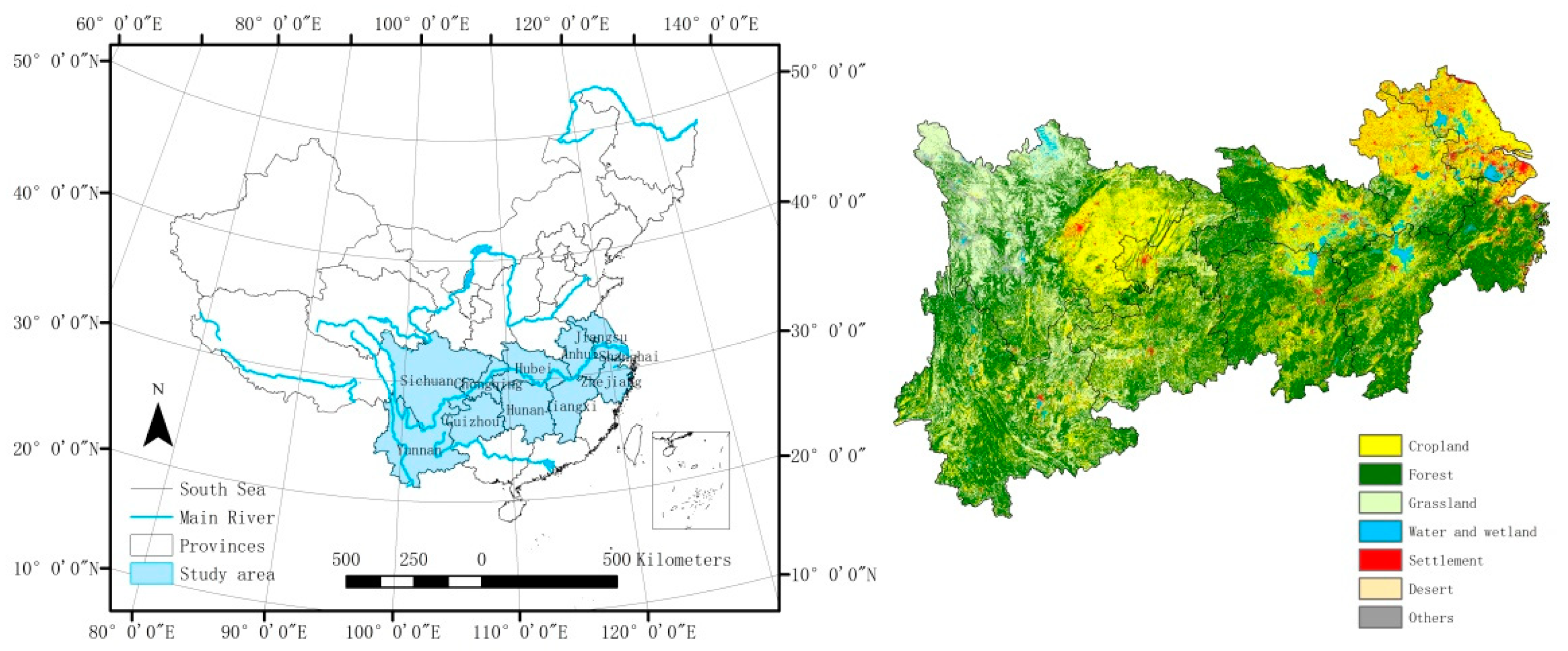
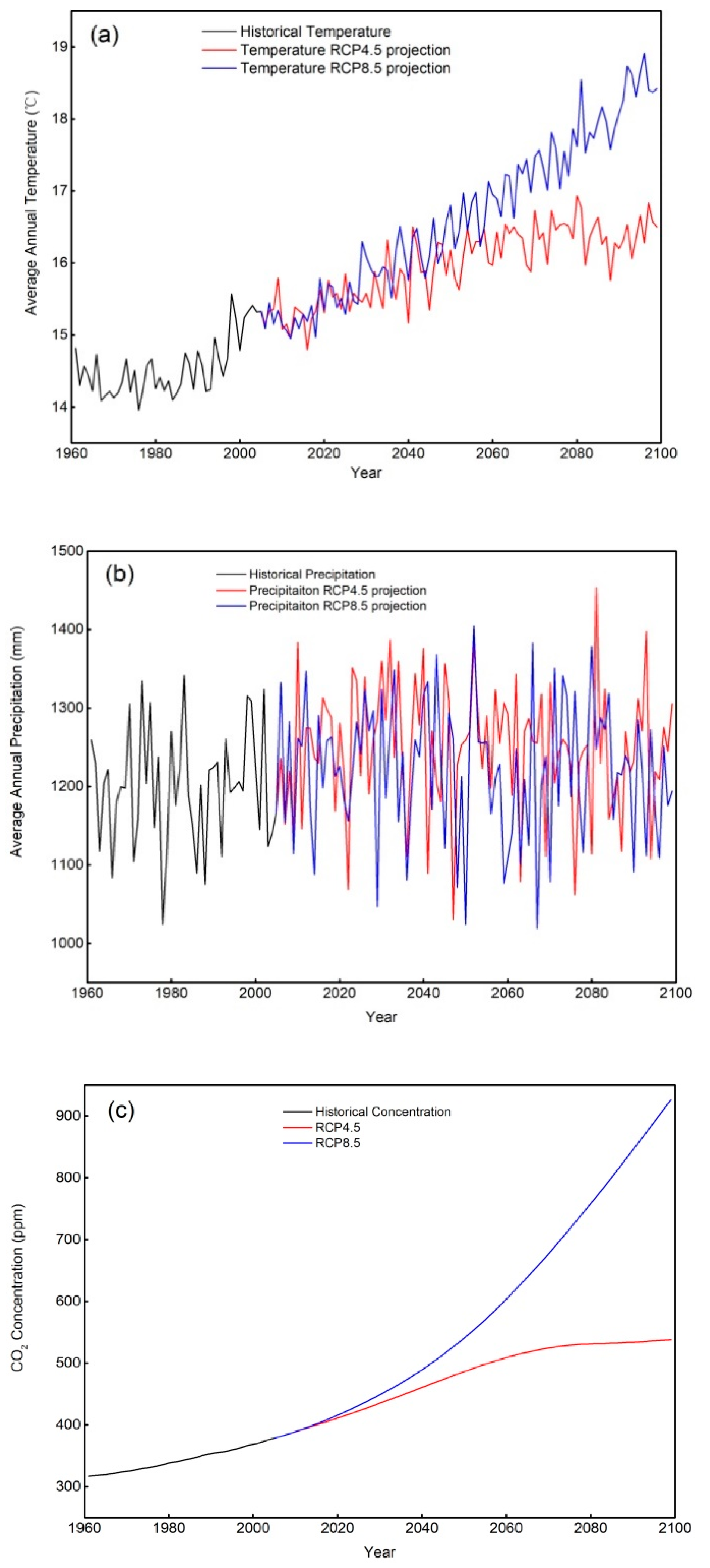

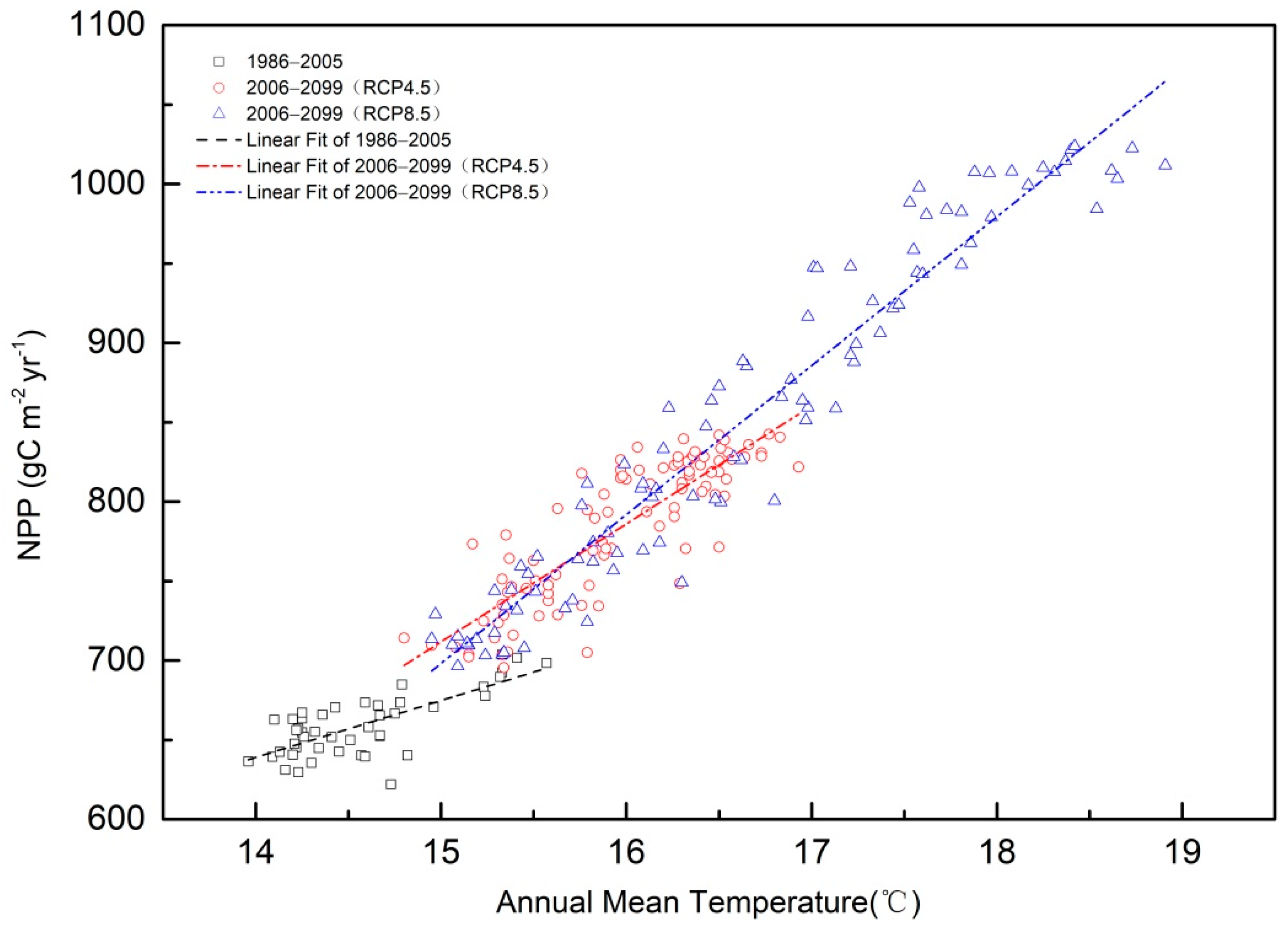
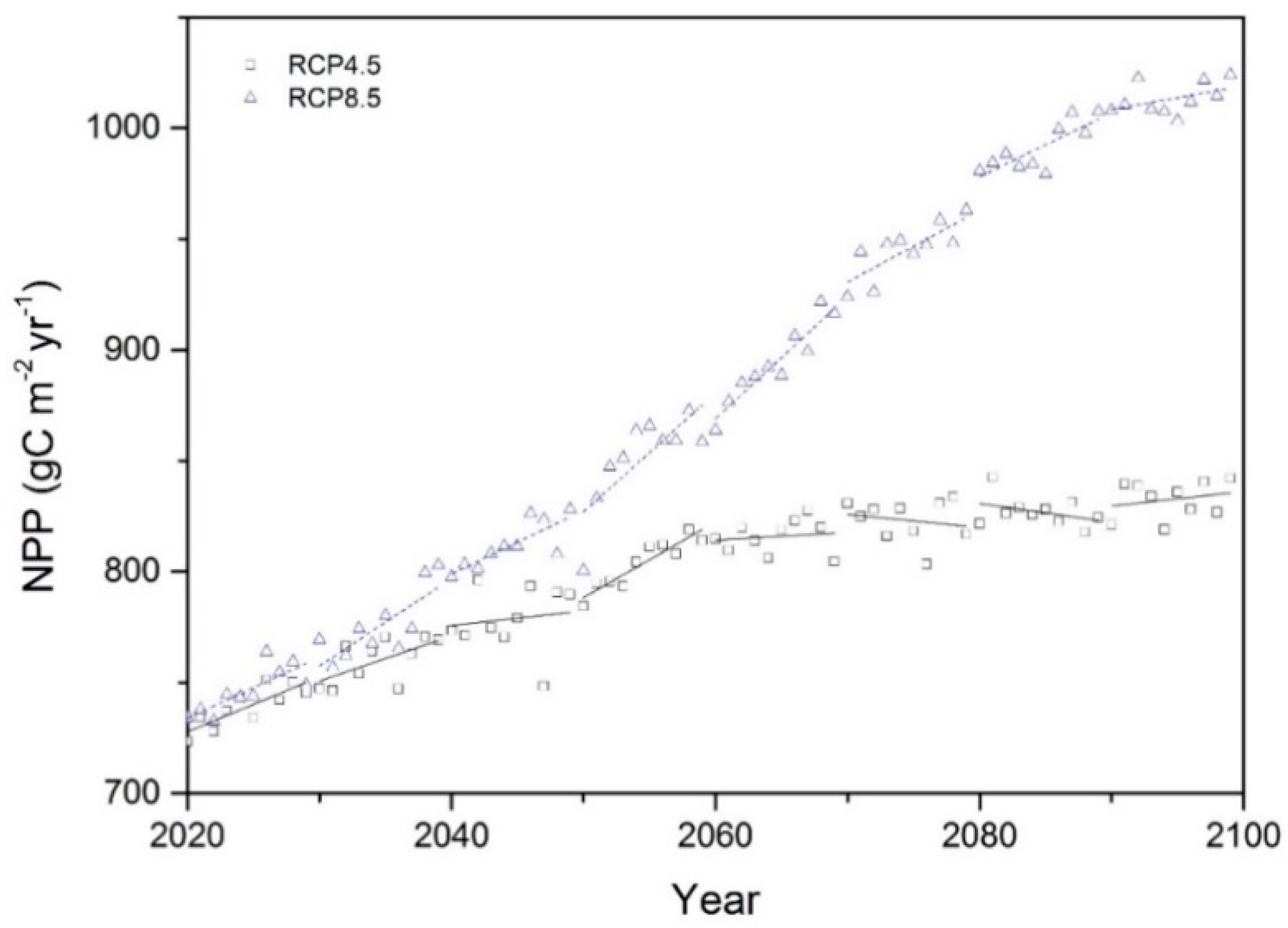
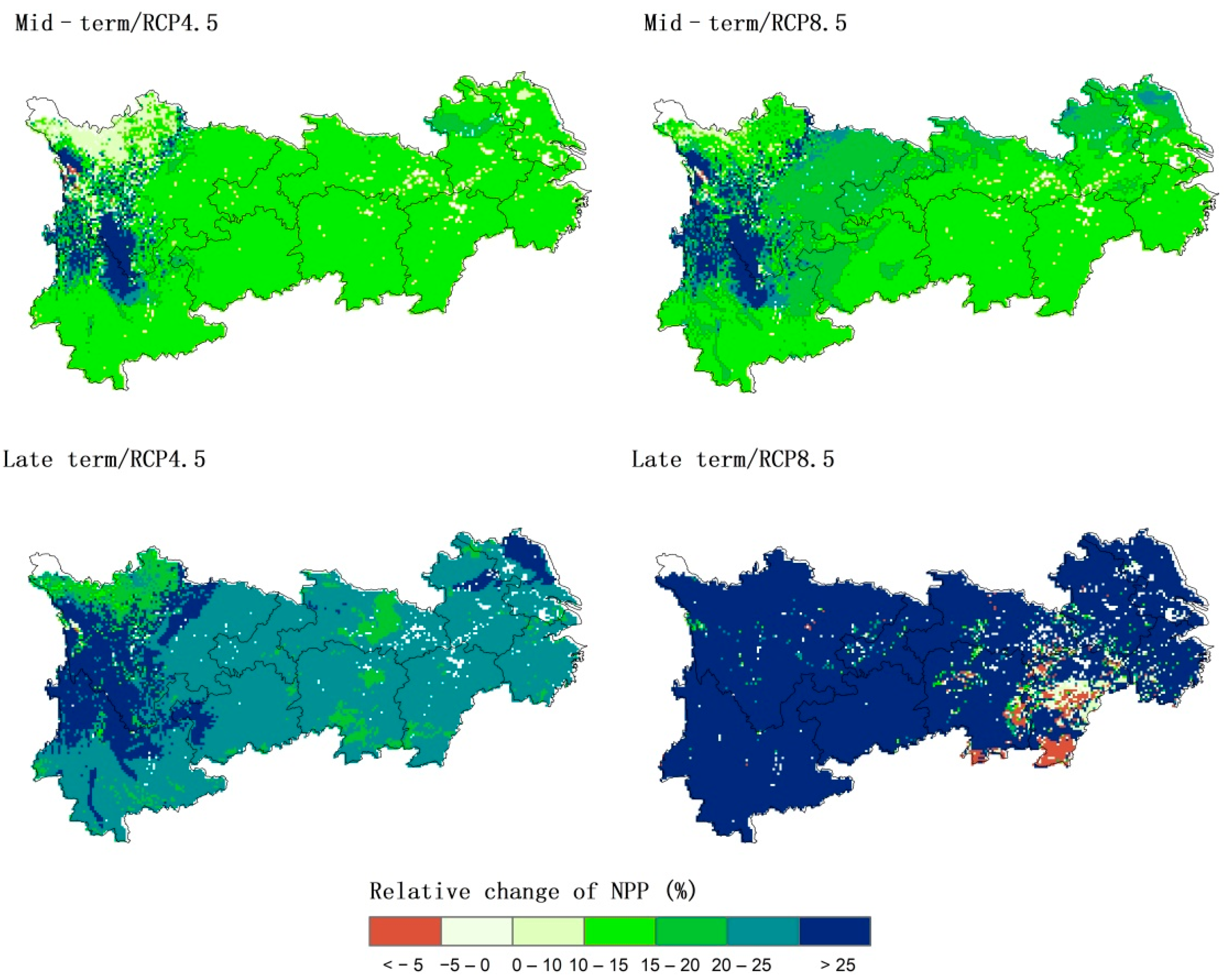
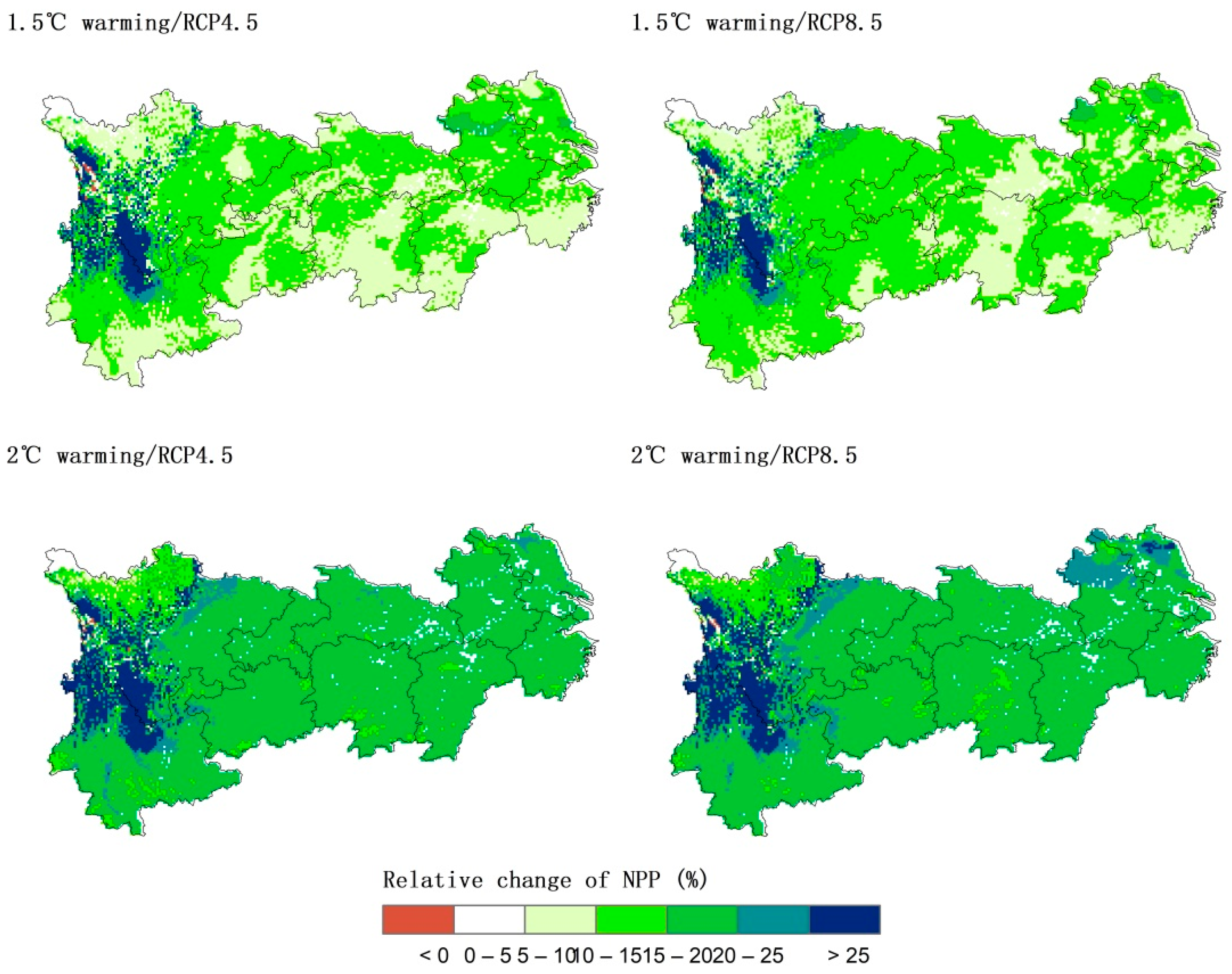
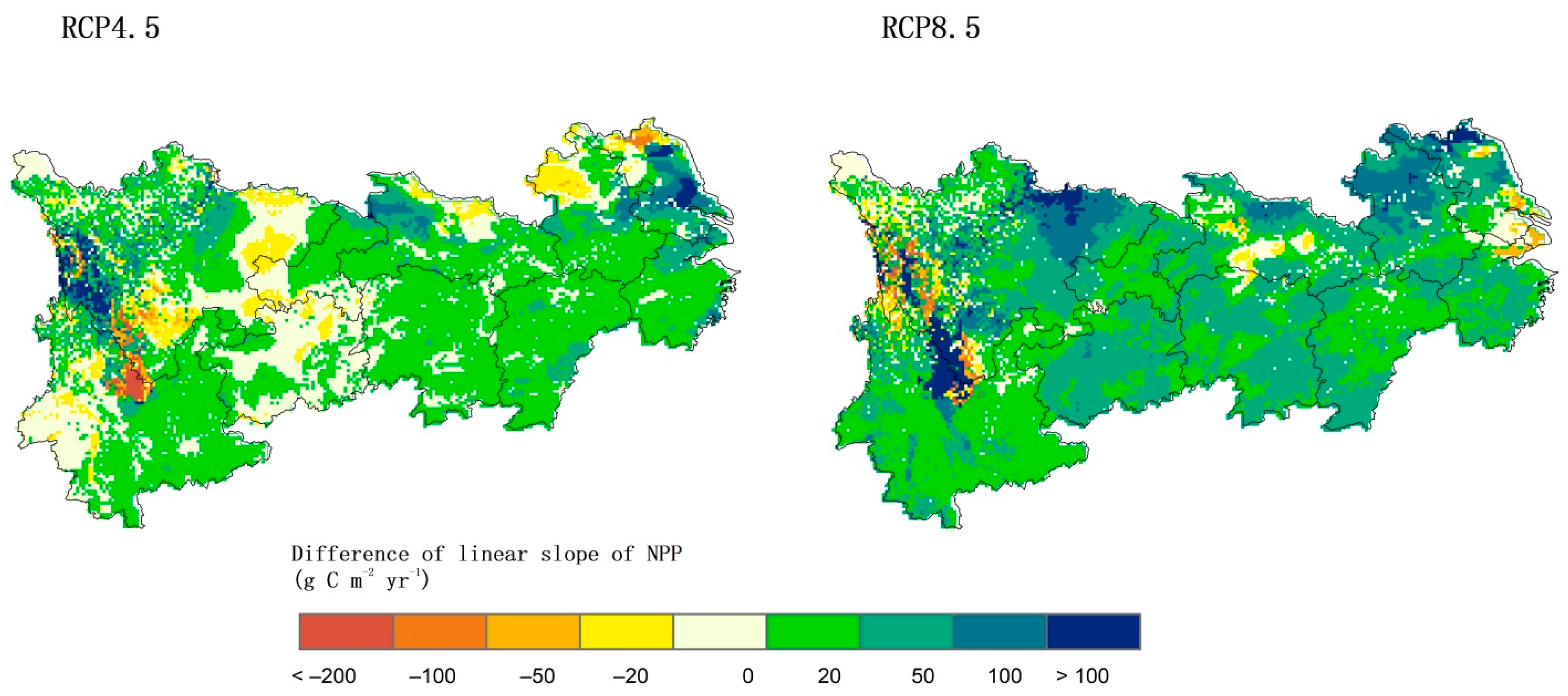
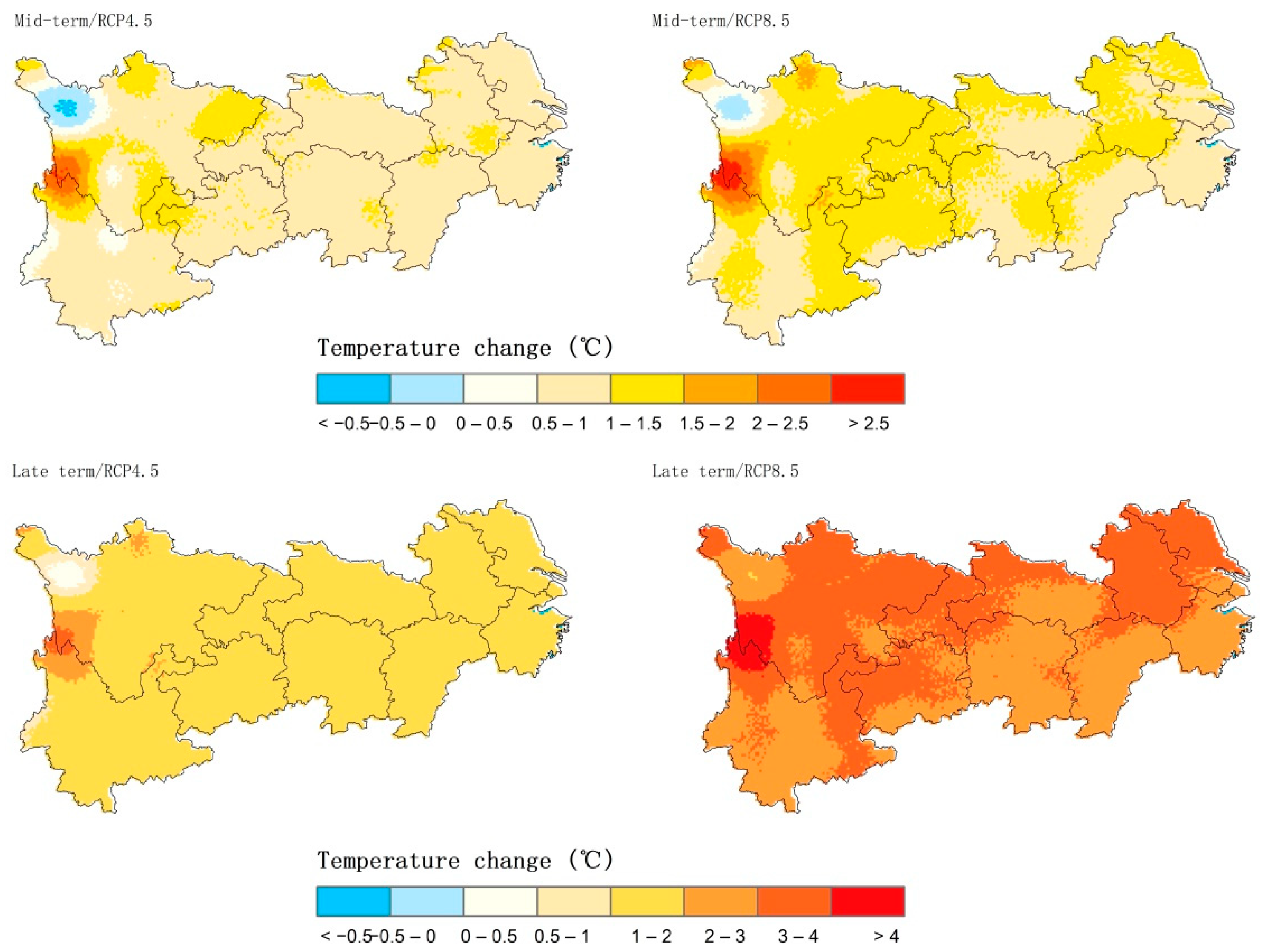
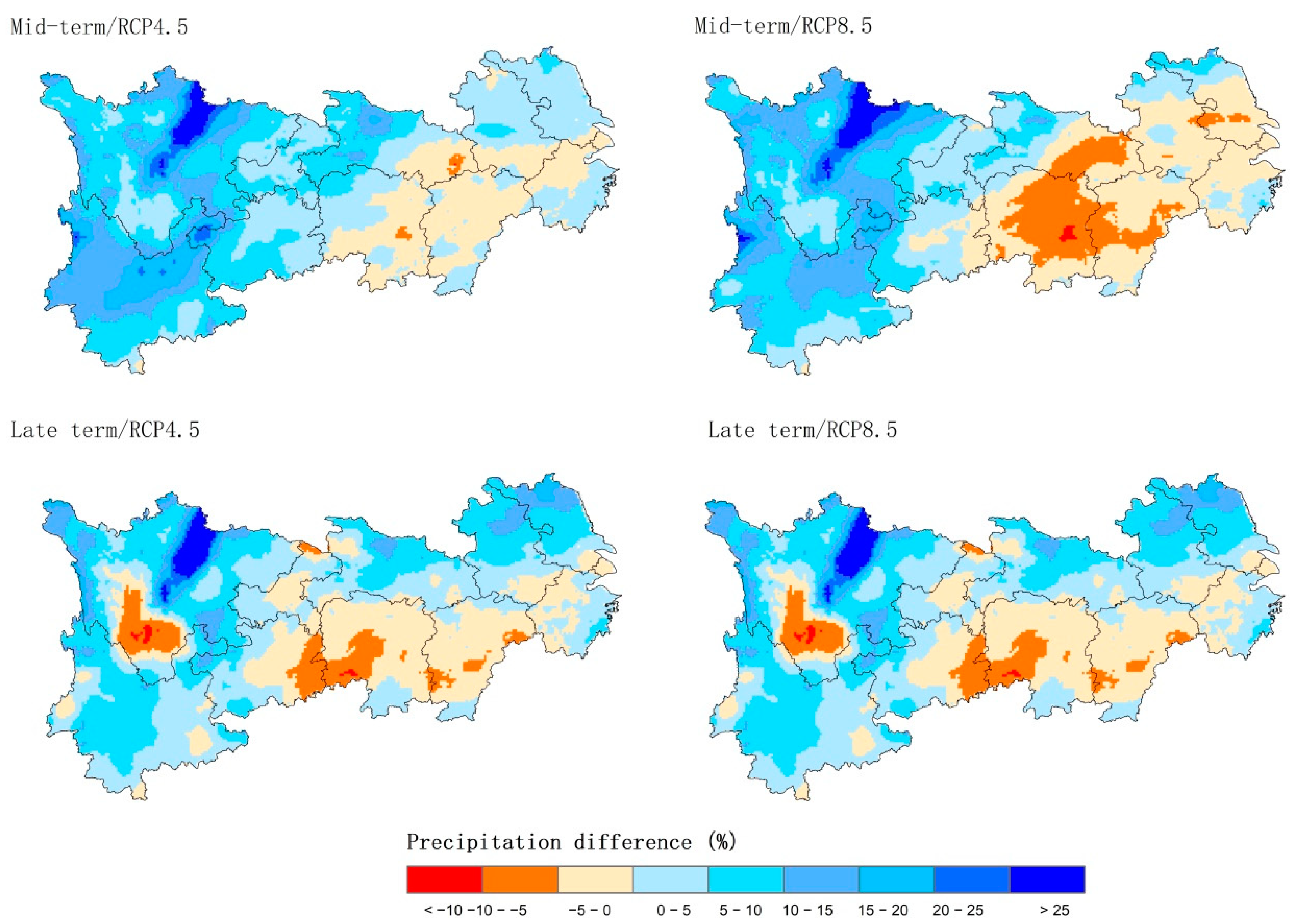
| Scenarios | Mid-Term | Late-Term | 1.5 °C Warming Period | 2 °C Warming Period |
|---|---|---|---|---|
| RCP4.5 | 2020–2049 | 2070–2099 | 2020–2039 | 2040–2059 |
| RCP8.5 | 2020–2049 | 2070–2099 | 2017–2036 | 2030–2049 |
| 2021–2049 | 2070–2099 | 2021–2099 | ||
|---|---|---|---|---|
| RCP4.5 | T | 0.04 | 0.61 ** | 0.39 ** |
| P | 0.55 ** | 0.35 | 0.38 ** | |
| RCP8.5 | T | 0.27 | −0.01 | 0.15 |
| P | 0.58 ** | 0.52 * | 0.52 * |
Publisher’s Note: MDPI stays neutral with regard to jurisdictional claims in published maps and institutional affiliations. |
© 2022 by the authors. Licensee MDPI, Basel, Switzerland. This article is an open access article distributed under the terms and conditions of the Creative Commons Attribution (CC BY) license (https://creativecommons.org/licenses/by/4.0/).
Share and Cite
Yu, L.; Zhou, B.; Xu, Y.; Zhang, Y.; Gu, F. Projections of the Net Primary Production of Terrestrial Ecosystem and Spatiotemporal Responses to Climate Change in the Yangtze River Economic Belt. Diversity 2022, 14, 327. https://doi.org/10.3390/d14050327
Yu L, Zhou B, Xu Y, Zhang Y, Gu F. Projections of the Net Primary Production of Terrestrial Ecosystem and Spatiotemporal Responses to Climate Change in the Yangtze River Economic Belt. Diversity. 2022; 14(5):327. https://doi.org/10.3390/d14050327
Chicago/Turabian StyleYu, Li, Botao Zhou, Yuqing Xu, Yongxiang Zhang, and Fengxue Gu. 2022. "Projections of the Net Primary Production of Terrestrial Ecosystem and Spatiotemporal Responses to Climate Change in the Yangtze River Economic Belt" Diversity 14, no. 5: 327. https://doi.org/10.3390/d14050327
APA StyleYu, L., Zhou, B., Xu, Y., Zhang, Y., & Gu, F. (2022). Projections of the Net Primary Production of Terrestrial Ecosystem and Spatiotemporal Responses to Climate Change in the Yangtze River Economic Belt. Diversity, 14(5), 327. https://doi.org/10.3390/d14050327






